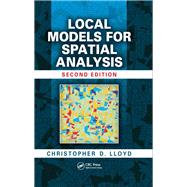
Note: Supplemental materials are not guaranteed with Rental or Used book purchases.
Purchase Benefits
Looking to rent a book? Rent Local Models for Spatial Analysis [ISBN: 9781439829233] for the semester, quarter, and short term or search our site for other textbooks by Christopher D. Lloyd. Renting a textbook can save you up to 90% from the cost of buying.
| Introduction | |
| Remit Of This Book | |
| Local Models and Methods | |
| What Is Local? | |
| Spatial Dependence and Autocorrelation | |
| Spatial Scale | |
| Stationarity | |
| Spatial Data Models | |
| Datasets Used for Illustrative Purposes | |
| A Note on Notation | |
| Overview | |
| Local Modelling | |
| Standard Methods and Local Variations | |
| Approaches to Local Adaptation | |
| Stratification or Segmentation of Spatial Data | |
| Moving Window/Kernel Methods | |
| Locally-Varying Model Parameters | |
| Transforming and Detrending Spatial Data | |
| Categorising Local Statistical Models | |
| Local Models And Methods And The Structure Of The Book | |
| Overview | |
| Grid Data | |
| Exploring Spatial Variation in Gridded Variables | |
| Global Univariate Statistics | |
| Local Univariate Statistics | |
| Analysis of Grid Data | |
| Moving Windows for Grid Analysis | |
| Wavelets | |
| Segmentation | |
| Analysis of Digital Elevation Models | |
| Overview | |
| Spatial Patterning in Single Variables | |
| Local Summary Statistics | |
| Geographically Weighted Statistics | |
| Spatial Autocorrelation: Global Measures | |
| Spatial Association and Categorical Data | |
| Other Issues | |
| Overview | |
| Spatial Relations | |
| Global Regression | |
| Spatial and Local Regression | |
| Regression and Spatial Data | |
| Spatial Autoregressive Models | |
| Multilevel Modelling | |
| Allowing for Local Variation in Model Parameters | |
| Moving Window Regression (Mwr) | |
| Geographically Weighted Regression (Gwr) | |
| Spatially Weighted Classification | |
| Local Regression Methods: Some Pros and Cons | |
| Overview | |
| Spatial Prediction | |
| Deterministic Methods, Curve Fitting, and Smoothing | |
| Point Interpolation | |
| Global Methods | |
| Local Methods | |
| Areal Interpolation | |
| General Approaches: Overlay | |
| Local Models and Local Data | |
| Limitations: Point And Areal Interpolation | |
| Overview | |
| Spatial Prediction | |
| Geostatistics | |
| Random Function Models | |
| Stationarity | |
| Exploring Spatial Variation | |
| Kriging | |
| Globally Constant Mean: Simple Kriging | |
| Locally Constant Mean Models | |
| Ordinary Kriging | |
| Cokriging | |
| Equivalence of Splines And Kriging | |
| Conditional Simulation | |
| The Change of Support Problem | |
| Other Approaches | |
| Local Approaches: Nonstationary Models | |
| Nonstationary Mean | |
| Nonstationary Models For Prediction | |
| Nonstationary Variogram | |
| Variograms in Texture Analysis | |
| Summary | |
| Point Patterns and Cluster Detection | |
| Point Patterns | |
| Visual Examination of Point Patterns | |
| Measuring Event Intensity And Distance Methods | |
| Statistical Tests of Point Patterns | |
| Global Methods | |
| Measuring Event Intensity | |
| Distance Methods | |
| Other Issues | |
| Local Methods | |
| Measuring Event Intensity Locally | |
| Accounting For The Population at Risk | |
| The Local K Function | |
| Point Patterns and Detection of Clusters | |
| Overview | |
| Summary: Local Models for Spatial Analysis | |
| Review | |
| Issues | |
| Software | |
| Future Developments | |
| Summary | |
| A Software | |
| References | |
| Index | |
| Table of Contents provided by Publisher. All Rights Reserved. |
The New copy of this book will include any supplemental materials advertised. Please check the title of the book to determine if it should include any access cards, study guides, lab manuals, CDs, etc.
The Used, Rental and eBook copies of this book are not guaranteed to include any supplemental materials. Typically, only the book itself is included. This is true even if the title states it includes any access cards, study guides, lab manuals, CDs, etc.